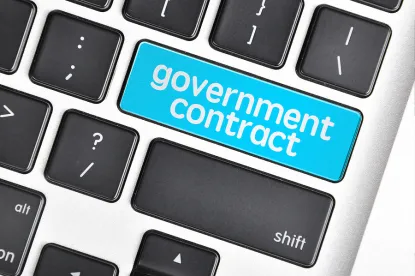With the Biden administration’s transition into power last week, federal contractors can finally rejoice about the end of a tumultuous 2020, which brought a global pandemic and a flurry of last-minute procurement policy changes from the outgoing Trump administration. Yet in true “no rest for the weary” fashion, federal contractors should prepare for significant developments ranging from supply chain initiatives, to infrastructure development, to likely increased compliance obligations and increased enforcement actions. While we wait for the Biden administration’s procurement policies to fully unfold, we review the significant developments impacting government contractors from 2020 and provide insight into President Biden’s key procurement priorities for the next four years.
A Look Back at 2020
Before we explore our predictions for procurement under the Biden administration, let’s take a look back at the major developments that had government contractors talking last year.
COVID-19 Response
As the COVID-19 pandemic began to cripple the nation’s economy, federal lawmakers swiftly enacted the Coronavirus Aid, Relief and Economic Security (CARES) Act, a multitrillion-dollar stimulus package that included several initiatives available to federal contractors.
-
The CARES Act offered much needed financial relief to small businesses struggling to weather the COVID-19 pandemic. Under the Act’s Paycheck Protection Program (PPP), any business or nonprofit that met eligibility requirements could seek relief under a Small Business Administration (SBA) lending program designed to keep employees on the company payroll. Critically, the program promised loan forgiveness to companies that used the loan proceeds on eligible expenses and retained their full staff and payroll during the eight to twenty-four week covered period. The SBA’s program rollout, however, faced many challenges including funding shortages, questions about whether lenders were prioritizing those businesses that needed funding the most, and several publicized instances of fraudulent PPP loan applications. In addition, government contractors may not be eligible for loan forgiveness to the extent amounts received for contract performance are used to cover payroll costs. Recent legislation signed December 27, 2020, provides an additional $284 billion in PPP funding, offers qualifying businesses an opportunity to obtain a second PPP loan, and expands the expenses for which businesses may put their PPP loan to use. Trying to keep up with the latest PPP developments? Check out our in-depth analyses “How to Determine Eligibility Under SBA Affiliation Rules for the CARES Act Paycheck Protection Program,” “SBA Issues Supplemental Guidance on the Paycheck Protection Program As Congress Replenishes Funding for Small Business Loans” and “Congress Provides Additional Funding and Guidelines for Paycheck Protection Program in Latest Stimulus Package.”
-
Although the other CARES Act loan programs, including the Treasury loans focused on the aviation industry and the Main Street Loan Program, which terminated on January 8, 2021, did not receive the same amount of press as the PPP loans, they also experienced challenging rollouts. These loan programs imposed a number of restrictions, including limits on executive pay going forward.
-
Throughout 2020, government contractors played critical roles in the fight against COVID-19. Recognizing this, the Secretary of Health and Human Services issued a March 2020 Public Readiness and Emergency Preparedness (PREP) Act declaration to immunize certain individuals and entities from liabilities arising from the manufacture, testing, development, distribution, administration and use of “covered countermeasures” against threats during the COVID-19 public health emergency. Section 3103 of the CARES Act then extended these protections to medical device manufacturers developing and distributing personal protective equipment and other medical devices. The COVID-19 PREP Act declaration has been amended several times, most recently on December 3, 2020. Our team extensively covered the scope and application of the PREP Act to the COVID-19 pandemic response in “CARES Act Expands Liability Protections Under the PREP Act,” “Whether Negligence, IP or Contract Claims — All May Be Covered Under PREP Act Immunity“ “PREP Act Case Law and Its Application to Today’s COVID-19 Crisis” and “Department of Health and Human Services Amends PREP Act Declaration.”
Cybersecurity
Defense contractors found themselves preparing for the rollout of the Cybersecurity Maturity Model Certification (CMMC), which establishes a unified cybersecurity standard for the Department of Defense (DOD) by rating contractors into five incremental tiers of relative cybersecurity maturity. In a sweeping change to how the DOD manages contractor cybersecurity, the CMMC framework does not permit contractors to self-certify their compliance. Furthermore, it deems contractors that fail to meet the CMMC level applicable to a solicitation as ineligible for contract award. DOD released version 1.0 of the CMMC in January 2020 and published a much-anticipated interim rule in September to implement the framework at DFARS 252.204-7012. Need a refresher on the new CMMC requirements? Our team covered what every defense contractor needs to know in “DOD’s Cybersecurity Maturity Model Certification Program Takes a Step Forward.”
Supply Chain Management
Throughout 2020, contractors endured numerous regulatory and legislative changes that impacted contractor supply chains, both domestically and globally.
-
Notably, the Trump administration continued to pursue aggressive action against foreign technology companies that threatened the security of U.S. supply chains. On July 14, 2020, the federal government published an interim FAR rule to implement Section 889(a)(1)(B) of the 2019 National Defense Authorization Act (NDAA). A significant change that affects most federal contractors, “Part B” broadly prohibits federal contractors from using banned telecommunications equipment and services produced by certain Chinese companies and their subsidiaries or affiliates. The rule prohibits executive agencies from contracting with federal contractors who use such equipment or services “as a substantial or essential component of any system, or as critical technology as part of any system,” and further requires contractors to represent annually their non-use of any prohibited equipment. The rule went into effect on August 13, 2020.
-
The year 2020 saw contractors enduring yet another shift in the Buy American landscape. In September 2020, the FAR Council finally issued a proposed rule to implement the Buy American Act (BAA) requirements of President Trump’s 2019 Executive Order 13881, “Maximizing Use of American-Made Goods, Products, and Materials.” If adopted, the rule would amend FAR Part 25 to substantially increase the domestic component percentage of qualifying end-products and the domestic product price preference under the BAA. Our team’s in-depth analysis of the proposed rule is available in “Proposed Buy American Act Rule Imposes Stricter Domestic Sourcing Requirements on Government Contractors.”
-
Additionally on the Buy American front, on August 6, 2020, President Trump signed the “Executive Order on Ensuring Essential Medicines, Medical Countermeasures, and Critical Inputs Are Made in the United States.” This lengthy EO imposes a number of new obligations for both executive branch agencies and contractors. Among other things, the EO requires the government to purchase “essential” medicines and medical supplies, as identified by the FDA, that are produced domestically and expands sole source contracting authority in order to permit the government to achieve this goal. A number of the EO’s requirements are likely at odds with agency procurement rules, and it is unclear how they will play out in light of the anticipated invocation of the Defense Production Act (DPA) by President Biden.
-
On August 3, 2020, President Trump signed an EO titled “Aligning Federal Contracting and Hiring Practices with the Interests of American Workers.” The EO focused on enforcing immigration laws and understanding how federal government contractors’ use of foreign labor impacts the U.S. labor market and national security. It remains unclear whether the EO will impact contractors’ ability to hire qualified personnel, specifically H-1B visa holders.
Workplace Diversity Training
On September 22, 2020, President Trump issued the unprecedented and controversial “Executive Order on Combating Race and Sex Stereotyping” (EO 13950), which imposed on federal contractors new workplace training restrictions related to diversity and inclusion, sexual harassment and other equal opportunity trainings. Following a nationwide preliminary injunction on enforcement of the EO, President Biden used his newly acquired EO authority to revoke the highly contentious EO on January 20, his first day in office, with “The Executive Order on Advancing Racial Equity and Support for Underserved Communities Through the Federal Government.”
What’s to Come Under the Biden Administration
Major government contracting trends that defined 2020, such as cybersecurity and domestic preference initiatives, are likely to continue into 2021. In addition, contractors can expect to see a swath of changes related to the Biden administration’s key priorities: developing resilient and environmentally friendly infrastructure, implementing a rapid and efficient pandemic response, strengthening the supply chain for critical medical supplies and for American businesses, and spurring enforcement actions and white collar investigations. Critically and consistent with the administration’s priority of getting the pandemic under control, President Biden signed the “Executive Order on a Sustainable Public Health Supply Chain,” which directs federal agencies to use the DPA to ramp up production and acquisition of personal protective equipment (PPE), respiratory devices, test kits, antivirals, vaccines and anything else needed to combat the COVID-19 pandemic. Below, our team breaks down the areas that will shape federal contracting during the next four years.
Infrastructure
Contractors should expect the Biden administration to prioritize spending on U.S. infrastructure. During his election campaign, President Biden outlined a trillion dollar investment to build resilient infrastructure and encourage American innovation. In particular, the Biden administration has emphasized the convergence of infrastructure spending and climate change, focusing on clean energy and greenhouse gas reduction. For example, he proposes to fortify the nation’s infrastructure to withstand the effects of climate change, to enact a national strategy to develop a low-carbon manufacturing sector in every state, to construct net-zero-carbon federal buildings, and to create a new cross-agency Advanced Research Projects Agency on Climate (ARPA-C) to research and develop innovative clean energy technologies. Of course, while contractors will certainly benefit from such a massive infusion of funding for infrastructure projects, they should pay close attention to any strings attached to such funding. It is likely that contractors will face more stringent compliance obligations, such as adherence to labor laws, environmental regulations or energy consumption targets.
Once again, small business contractors could be the winners here if the Biden administration leverages infrastructure spending as a form of “stimulus.” The Biden campaign has emphasized its plan “to support small businesses and tackle inequities in the federal contracting system,” such as by tripling the federal government’s contracting goal for small, disadvantaged businesses by 2025 and by requiring prime contractors to increase subcontracting opportunities for small disadvantaged businesses.
Finally, while his strategic policy broadly encompasses procurement opportunities for construction, transit, energy and telecommunication, there is one project noticeably missing: border wall construction. President Biden repeatedly stated his intent on the campaign trail to end continued project funding, and on January 20 he signed an executive order to halt border wall construction and to order a review of existing contracts and funding.
Green Buying
Complementing his climate change-focused infrastructure plans, President Biden has signaled a commitment to environmentally sustainable procurement generally. For example, his climate plan touts leveraging federal buying power “to drive towards 100% clean energy and zero-emissions vehicles.” His administration has also pledged to purchase green technologies, such as batteries and building materials, to position the United States as a global leader in clean energy. Furthermore, as several of his cabinet nominees have significant state-level climate experience, the way could be paved toward renewed federal and state partnerships on these initiatives.
All of this suggests that green sourcing rules may be a critical pillar on President Biden’s procurement policy agenda. Contractors should keep an eye out for new requirements related to agency and contractor emissions reductions, heightened environmental standards and price preferences for climate-friendly products. The regulatory process to implement new procurement regulations is lengthy, however, so any immediate action is likely to occur through his use of executive order authority.
Supply Chain Resiliency and Domestic Preferences
As under President Trump, government contractors can expect the Biden administration to emphasize domestic product preferences and initiatives. The Biden platform commits to a $400 billion procurement investment into American-made products and prioritizes “Buy American” Act (BAA) initiatives, with a particular focus on those areas consistent with President Biden’s other priorities, including clean energy, advanced technologies and critical medical supplies. Taking the first steps to implement his vision, President Biden signed the executive order “Ensuring the Future is Made in All of America by All of America’s Workers“ on January 25. The EO aims to leverage federal purchasing power to strengthen domestic manufacturing by, among other things, redefining and tightening domestic content requirements. In addition, the EO seeks to close existing “Buy American” loopholes, to restrain the use of waivers available to contractors and federal agencies, and to make any waivers more transparent. Specifically, the EO directs regulators to tighten the definition of American-made products and creates a position in the Office of Management and Budget to oversee stepped-up purchases of domestic goods. The EO will make it harder for federal agencies to issue waivers, and directs the creation of a website that will identify all proposed BAA waivers. The EO directs the FAR Council to review issues of BAA enforcement and to make appropriate changes to relevant FAR provisions to replace the component test and to increase the domestic content and price preference thresholds. Executive branch agencies are also directed to submit reports within 180 days to the Office of Management and Budget’s Made in America director addressing the agency’s implementation of and compliance with Made in America laws. While this EO represents a fulfillment of President Biden’s campaign promises, there remain a number of questions including how this EO will impact the Trade Agreements Act’s exception to the Buy American Act and the realities of global supply chains.
Contractors should also expect a continued focus on strengthening U.S. supply chains, particularly for critical medical supplies necessary to combat the COVID-19 pandemic. In his “National Strategy for the COVID-19 Response and Pandemic Preparedness” released on January 21, President Biden called for the immediate and expanded use of the DPA to rectify coronavirus-related supply shortfalls. His administration has signaled that Biden will aggressively invoke the DPA to accelerate the production of syringes, raw materials used in vaccines and PPE supplies such as N95 masks, isolation gowns and gloves. This strategy complements President Biden’s “Executive Order on a Sustainable Public Health Supply Chain,” issued on the same day, which directs federal agencies to leverage the DPA and all other available legal authorities to bolster supply chains for critical medical supplies. In addition to these efforts, the Biden platform demands a 100-day supply chain review to assess vulnerabilities in critical sectors and proposes the expanded use of the Biomedical Advanced Research and Development Authority (BARDA) to procure COVID-19 related supplies.
Finally, in an effort to support “good American jobs,” the Biden platform will require contractors that receive a federal procurement contract to commit to a $15 minimum wage. Small business contractors will likely have mixed reactions to such a directive.
Cybersecurity
Contractors can expect cybersecurity to be a priority under the Biden administration, as the president recently outlined a $10 billion plan to strengthen federal cybersecurity and IT modernization initiatives. Funding priorities include improved monitoring and incident response across federal agencies as well as transformational projects within the General Services Administration. The Biden administration, however, has yet to release detailed strategic objectives or specific cybersecurity policies. On the regulatory side, contractors should not be surprised if new or additional requirements arise as a result of President Biden’s planned cybersecurity modernization efforts. In addition, efforts related to the DoD’s CMMC initiative will continue and there is no indication that the Biden platform will significantly modify existing CMMC requirements.
Enforcement and Compliance
As with prior Democratic administrations, the Biden administration will likely increase oversight over federal procurement. Contractors should anticipate expanded enforcement actions and white collar investigations, particularly prosecutions involving the False Claims Act and the Foreign Corrupt Practices Act. Similarly, loan forgiveness applications pursuant to the Paycheck Protection Program may receive more attention.
In addition, Biden has proposed granting full subpoena power to inspectors general in an effort to combat unethical or improper behavior. He has also proposed to issue an executive order prohibiting White House personnel from interfering with federal agencies on procurement-related matters. In fact, he plans to require the public disclosure of any individual or entity that attempts to solicit White House help in such matters. Further, the Biden administration aims to “close the federal contractor loophole” to prohibit officers and directors of federal contractors from contributing to federal candidates to avoid improper influence of contract awards.
Conclusion
Contractors should note that while the Biden administration’s platform is certainly ambitious, it is unlikely that every initiative will be implemented or achieved, much less in the next year. Regardless, as with recent administrations, we expect the Biden administration to rely on the liberal use of executive order authority to implement certain policy objectives. President Biden signed 17 executive orders on his first day in office and is expected to sign more in the coming days. Stay tuned throughout 2021 as Faegre Drinker’s Government Contracts team continues to analyze any procurement changes this new administration brings.








 />i
/>i
